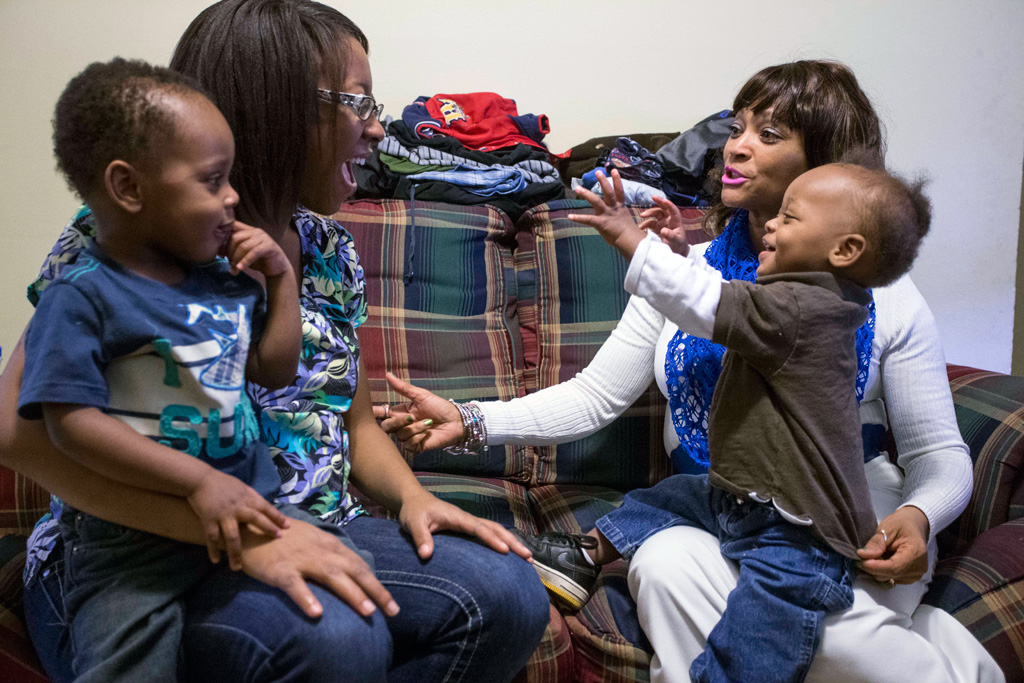
Demekia Kincaid, left, talks with Belinda Grant, right, about doctors’ appointments and family in March 2014. Kincaid was a participant in a Buncombe County program that worked to combat infant mortality among minority women. File photo by Alicia Funderburk/Carolina Public Press
By Rebecca Andrews, Carolina Public Press
Read more by Carolina Public Press at this link.
Many counties in North Carolina have an infant mortality rate well above the state average for 2017, which could be an indication of a lack of access to affordable health care and inadequate health education in these areas.
The N.C. Department of Health and Human Services reports a statewide infant mortality rate of 7.1 in 2017, down from 7.2 in 2016. Rates that were at least 50 percent higher than the state average existed in 22 percent of counties, with 10 percent of counties having rates more than double the state average.
Pamlico County, on the state’s central coast, had the highest rate for 2017 at 27.2, followed by two southwestern mountain counties, Cherokee at 22.6 and Clay at 22.5.
Infant mortality is defined as the death of an infant prior to his or her first birthday. The rates are calculated as the number of deaths per 1,000 births in a county, according to DHHS.
Counties with a low number of actual deaths can still have a high rate if the county has a small population or a low number of births in a year. The rates of counties based on fewer than 10 deaths should be interpreted cautiously, DHHS recommends.
When looking at low numbers, it can become hard to distinguish between random fluctuation and a trend.
Candace Baldwin, director of nursing for Cherokee County Health Department, said this is the case in Cherokee.
“The reason Cherokee County’s infant mortality rate rose to 22.6 in 2017 was because there were five infant deaths out of a total 221 live births, compared to one infant death out of a total 257 live births in 2016 for an infant mortality rate of 3.9,” Baldwin said.
Still, infant mortality rates are often considered an indicator of the overall health of children, women and families. Several factors, or social health determinants, impact infant mortality, including maternal health, environmental conditions, nutrition, socio-economic background, inequality and education.
“Social health determinants are conditions in our social or physical environment that contribute to our health. Access to care, the right type of providers in your area, being culturally and linguistically competent or having providers who are culturally and linguistically competent. Access to jobs, livable wages,” said Tony Lo Giudice, assistant public health director for Forsyth County, an urban county centered around Winston-Salem that had an infant mortality rate of 9.8 in 2017.
“I know they sound like political talking points, but research done has actually shown when you have these things in place, you tend to have a healthier community and healthier individuals.”
Parental education
Many counties combat infant mortality by increasing proper parental education.
Jackie Mueller, a nurse who volunteers with the Pregnancy and Parenting Center in Cherokee County, said the agency offers free parenting classes, counseling and supplies to pregnant women and new mothers.
“Some of them, if this is their first time pregnant, don’t know what to expect. One of the things we try to do is help them know what to expect, especially with the delivery and once the child is born,” Mueller said.
In Cherokee County, the Health Department provides education on safe-sleep practices and on the hazards of co-sleeping, which can increase the risk of sudden infant death, accidental strangulation or suffocation, Baldwin said.
Many women are also unaware of the importance of birth spacing.
“The current recommendation is that women have at least 18 months in the interpregnancy interval. We have been providing education on this and how less than 18 months between the birth of one child and the beginning of another pregnancy can be associated with preterm births and adverse birth outcomes,” Baldwin said.
In addition to accidental deaths, adverse health effects due to unhealthy pregnancies can cause infant deaths.
Nearly 1 in 3 North Carolina women who are pregnant either receive no prenatal care or enter prenatal care after the first trimester of pregnancy, according to the 2018 N.C. Health Equity Report. This proportion is even greater among minorities at 41.1 percent for Hispanic or Latino, 39.1 percent for African-Americans and 35.9 percent for American Indians.
Access to health care
Many people in areas with high infant mortality rates live in health care deserts, meaning there is a lack of nearby affordable health care options.
Aileen Searles, a pediatrician in Person County, along the Virginia line in the Piedmont, said patients frequently must travel several miles for specialized or affordable care, causing many to opt out of health care due to lack of transportation, financial reasons or lack of time. At 20.3, Person’s infant mortality rate in 2017 was nearly three times the state average and among the highest in the state.
“We don’t have an OB/GYN in our county at all,” Searles said. “We have limited resources at the Health Department where they can provide basics of care. But in regard to actually seeing an obstetrician, our patients have to drive into Durham.”
Searles estimates this can be about 30 miles, at least a 30-minute drive, and less than half of the population in Person County have vehicles. Some can’t afford to take time from work to make these drives.
If a woman were to go into labor suddenly, she could go to the local hospital, but there are no obstetrics services there.
“If it were absolutely critical, they could deliver a baby there, but they have no means of caring for the baby or mother after the fact. They don’t have incubators or anything they would need for a complicated delivery,” Searles said.
Citizens of Pamlico County are in a similar situation: They must drive to New Bern in Craven County to see an OB/GYN for prenatal and postnatal care, according to Debbie Green, director of human services in Pamlico County.
“If they get Medicaid and it’s a health-related, Medicaid-paid service, they can get Medicaid transportation, which is provided through CARTS, Craven Area Rural Transit System,” Green said.
Even after birth, health care for children can be difficult to find. While there are family and internal medicine practices that see kids, Searles is currently the only pediatrician in Person County. And she is the only pediatrician at a federally qualified medical clinic that sees patients with low income or no insurance.
If a child needs specialized care, especially as an infant, there may be a specialized doctor nearby, but the parent may still have to travel to find an affordable care program.
“Certainly, if there are more transportation options available, that would be helpful,” Green said. “I don’t know that putting another clinic down here would be a solution — maybe if there were more services offered through the Health Department.”
Substance abuse
Another primary factor common in rural counties is drug abuse, with opioid and tobacco use being some of the most prevalent.
“Smoking during pregnancy can have multiple outcomes, but most commonly what we see is small gestational age, so the baby doesn’t grow as well as it should,” Searles said. “Additionally, having tobacco use in the home, after birth, can create a whole lot of issues. Being around tobacco use increases the chance of sudden infant death. It worsens asthma, it worsens chronic nasal congestion or allergy symptoms.”
In Pamlico County, Green said the significant rise in opioid use over the past years has corresponded with an uptick in substance abuse-related cases of neglect, especially for infants who are entirely dependent on their caretaker.
“It affects them in many ways. It could lead to child neglect, parents not taking care of the kids as they need,” Green said. “It could be that their financial situation is affected because they are spending money on drugs, and using drugs often affects somebody’s ability to maintain employment.”
More resources needed
Most counties cited the need for more available resources and programs to address infant mortality. Searles’ clinic in Person works on starting a nutrition education program. Baldwin said she believes Cherokee County could benefit from Nurse-Family Partnership, which provides at-home visits from nurses for new mothers.
Lo Giudice, who oversees the Baby Love Plus program in Forsyth, said the agency does mental health and depression screenings but could benefit from increased mental health services to refer to.
“There are some social service agencies that probably do have prevention programs in place, however, we’re so rural we don’t have the extra funding to be able to have something like that,” Green said. “My staff are pretty much stretched and can’t go beyond and do some of that preventative work that would be really nice to be able to do.”
For more information
- County-by-county 2017 North Carolina infant mortality report, link
- North Carolina DHHS’ Perinatal Health Strategic Plan, 2016-20, link



There are no comments
Add yours